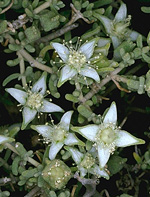 |
Most species of Aizoaceae are desert- or salt-adapted species, found in drier parts of Africa and the deserts of South America, and in Australia from the shrublands of Central Australia to strandlines around the southern coast. No species occur in the tropics.
Characteristic features of the family Aizoaceae in Australia include: - leaves usually fleshy, opposite, alternate or whorled
- flowers with a single true perianth whorl, sometimes with one or more whorls of petal-like staminodes
- stamens and staminodes often numerous
- ovary often with many carpels and free styles, developing into fleshy fruits or capsules
Description
Evergreen shrubs, or annual, biennial or perennial terrestrial herbs perennating by taproots or rarely tubers. Vegetative reproduction absent or by stolons. Stem internodes terete, oval, angled, winged or strongly flattened. Internal secretions not obvious. Plants glabrous or with simple, vesicular, stellate or vesicular, non-glandular, unicellular or uniseriate hairs or peltate scales. Leaves alternate and spiral or opposite, cauline or both basal and cauline if herbs, petiolate, subsessile or sessile. Stipules absent or present, free, scale-like, falling early. Lamina simple, symmetric, filiform, acicular, subulate, linear, lanceolate, ovate, elliptic, oblanceolate, ovate, oblong or orbicular; base cuneate, attenuate, rarely cordate; margins entire, ±flat, or revolute or recurved; venation pinnate, or not visible, with the midrib conspicuous or inconspicuous, and the tertiary venation not reticulate; surfaces punctate or not; herbaceous or succulent. All the flowers bisexual. Inflorescences terminal or axillary, consisting of dichasial cymes or solitary flowers. Bracts and bracteoles present or absent. Pollination by insects or wind. Flowers odourless, sessile or stalked. Floral disc present or absent; nectaries absent or present on the disc. Perianth of 1 whorl only, or 1 whorl dissimilar from the other, or up to 5 ±similar whorls, with 4–numerous segments, imbricate or valvate in bud. Calyx regular or rarely irregular; segments free or fused, with 4 or 5 sepals or lobes; cup-shaped; succulent; base rarely with spurs or pouches. Corolla regular; segments free, with 4–100 petals, usually with no clear relationship to the sepals or calyx lobes, greenish, white, cream, yellow, orange, pink, magenta or purple, without contrasting markings, or streaked, spotted, etc, membranous; lobes ±entire. Fertile stamens 4–numerous, alternating or not clearly correlated with the calyx segments or lobes, sometimes grouped into bundles, free, distinct from each other or fused by their filaments into an open or closed tube, all ±equal. Staminodes present or absent. Anthers dorsifixed or basifixed, versatile or not, opening sideways or inwards by longitudinal slits; 2-celled. Ovary superior and sessile or part-inferior or inferior. Carpels 1–20, fused; ovary with 1–20 locules. Style terminal, single and unbranched, or branched above or from the base. Ovules 1–numerous per locule, stalked; placentation basal, apical, parietal or axile. Fruit dehiscent or indehiscent; a dry circumscissile, septicidal or loculicidal capsule, or fleshy berry; the perianth on the maturing fruit rotting or liquefying, or dry and persistent, or growing larger. Disseminule micro-surface ±smooth, tuberculate, reticulate, colliculate or rugose, pink, red, purple, green, brown or black, dull or glossy. Seeds 1–numerous per fruit. Aril absent. Cotyledons 2. Embryo curved.
(Note: this description has been generated from the coded data compiled for the key. Any errors in the key data will be reflected in the descriptions.)
A treatment of the family Aizoaceae has been published in:
Flora of Australia 4: 19-62.
Australian genera of Aizoaceae (as recognised for the Flora of Australia)
† = some species native, others introduced
* = all species introduced
*Aptenia
*Carpanthea
†Carpobrotus
*Cleretum
*Conicosia
Disphyma
*Drosanthemum
*Galenia
Gunniopsis
*Lampranthus
*Mesembryanthemum
*Micropterum
*Psilocaulon
*Ruschia
Sarcozona
Sesuvium
†Tetragonia
Trianthema
Zaleya

|
  |

Carpobrotus sp. (flowering plant)
Photo: C.Green © ANBG

Disphyma australe (flowering plant)
Photo: M.Fagg © M.Fagg

Gunniopsis kochii (flowering plant)
Photo: P.Ollerenshaw © ANBG

Gunniopsis quadrifida (flowers)
Photo: M.Fagg © M.Fagg

|
 |
|